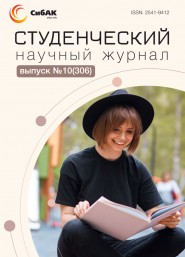Статья опубликована в рамках: Научного журнала «Студенческий» № 10(306)
Рубрика журнала: Педагогика
Скачать книгу(-и): скачать журнал часть 1, скачать журнал часть 2, скачать журнал часть 3, скачать журнал часть 4, скачать журнал часть 5
FORMATION OF SEMANTIC READING SKILLS AND WORKING WITH TEXT IN MATH LESSONS
ФОРМИРОВАНИЕ НАВЫКОВ СМЫСЛОВОГО ЧТЕНИЯ И РАБОТА С ТЕКСТОМ НА УРОКАХ МАТЕМАТИКИ
Хлудеева Ирина Валерьевна
студент, Белгородский государственный национальный исследовательский университет (НИУ «БелГУ»),
РФ, г. Белгород
Богачев Роман Евгеньевич
научный руководитель, канд. филол. наук, доц., Белгородский государственный национальный исследовательский университет (НИУ «БелГУ»),
РФ, г. Белгород
ABSTRACT
This work is devoted to the development of mathematical literacy of students through the effective solution of text problems. The relevance of the topic is due to the difficulty for students of mastering text tasks that require not only computing skills, but also meaningful analysis and understanding of the text. The development of semantic reading skills is directly related to the successful solution of text tasks. The paper offers methodological recommendations for making a short note of the task condition as a tool for the development of semantic reading.
The article proposes a classification of ways to make a short record of a condition: a diagram, keywords indicating the relationships between them, and a table. Each method is described in detail with examples of its application to various types of tasks: tasks for finding fractions of numbers and integers by the value of its fraction, tasks for movement and tasks for work. Special attention is paid to the use of keywords indicating relationships for fraction tasks and the use of tables for movement and work tasks.
Thus, the work provides practical tools for teachers aimed at improving the effectiveness of teaching text-based problem solving and developing students' mathematical literacy.
АННОТАЦИЯ
Данная работа посвящена развитию математической грамотности учащихся посредством эффективного решения текстовых задач. Актуальность темы обусловлена сложностью для учащихся овладения текстовыми задачами, требующими не только навыков вычисления, но и осмысленного анализа и понимания текста. Развитие навыков смыслового чтения напрямую связано с успешным решением текстовых задач. В работе предлагаются методические рекомендации по составлению краткой записи условия задачи как инструмента для развития смыслового чтения.
В статье предлагается классификация способов составления краткой записи условия: схема, ключевые слова с указанием связей между ними и таблица. Каждый способ детально описывается с примерами применения к различным типам задач: задачи на нахождение дроби от числа и целого по значению его дроби, задачи на движение и задачи на работу. Особое внимание уделяется использованию ключевых слов с указанием связей для задач на дроби и применению таблиц для задач на движение и работу.
Таким образом, работа предоставляет практические инструменты для учителей, направленные на повышение эффективности обучения решению текстовых задач и развития математической грамотности учащихся.
Keywords: functional literacy, mathematical literacy, students, mathematics, text tasks, assignments, techniques, activities.
Ключевые слова: функциональная грамотность, математическая грамотность, учащиеся, математика, текстовые задачи, задания, приёмы, деятельность.
Today, the need to quickly respond to all the changes taking place in life, the ability to independently find, analyze, and apply information, comes to the fore in the world. Functional literacy becomes the main thing, as it is "a person's ability to solve standard life tasks in various spheres of life and activity based on applied knowledge." One of its types is mathematical literacy. [1]
Mathematical literacy is the ability of a person to identify and understand the role of mathematics in the world in which he lives, to make well–founded mathematical judgments and to use mathematics in such a way as to meet the needs of a creative, interested and thinking citizen in the present and future. Students' mathematical literacy is directly related to the development of semantic and functional reading skills. Semantic reading strategies can be clearly traced in the stages of working on solving text problems in math lessons. To cope with the task, students must: intelligently read and listen to the text of the assignment; be able to extract and analyze information obtained from the text; be able to critically evaluate this information; be able to read tables, diagrams, diagrams, symbols. [2]
Text tasks have always been among the most difficult tasks for students to master, since, unlike specific tasks, the solution of which is performed according to a well-defined algorithm, they require meaningful reflection. One of the methods of developing semantic reading is making a short note of the task condition. The short entry form is divided into three ways: a diagram; keywords with links; a table. It is convenient to use keywords indicating the relationships between quantities when solving problems of finding fractions of a number and an integer by the value of its fraction. First, the keywords in the problem are written out, then the known values are found in the text and written to the corresponding keywords, if the value is unknown, then a "?" sign is placed. Then the arrows indicate the relationships between these keywords. [2]
I apply the use of the table when making a short record to movement and work tasks.
The main features of the proposed approach are related to the fact that the main task is focused on a thorough reading of the proposed text. In order for reading to become meaningful, it is necessary that it be accompanied by an additional task, for example, the selection of keywords, step-by-step filling in the table. These techniques develop the student's skills of working with written text, teach them to analyze data, logically structure information, choose the main thing, and also improve the quality of learning activities in general. [1]
References:
- Kuropyatnik I.V. Reading as a strategically important competence for young people// Pedagogical workshop. Everything is for the teacher. 2012. – 6 с.
- Federal State educational standard of basic general Education. URL: https://sh-almyakovskaya r69.gosweb.gosuslugi.ru/netcat_files/33/46/FGOS_OOO_2024_2025_uch._g..pdf (date of address 13.03.2025)
- Smetannikova N.N. Teaching reading strategies in grades 5-9: How to implement the Federal State Budget. Moscow: Balass, 2011- 12 с.


Оставить комментарий